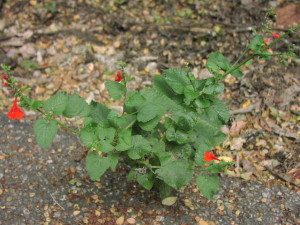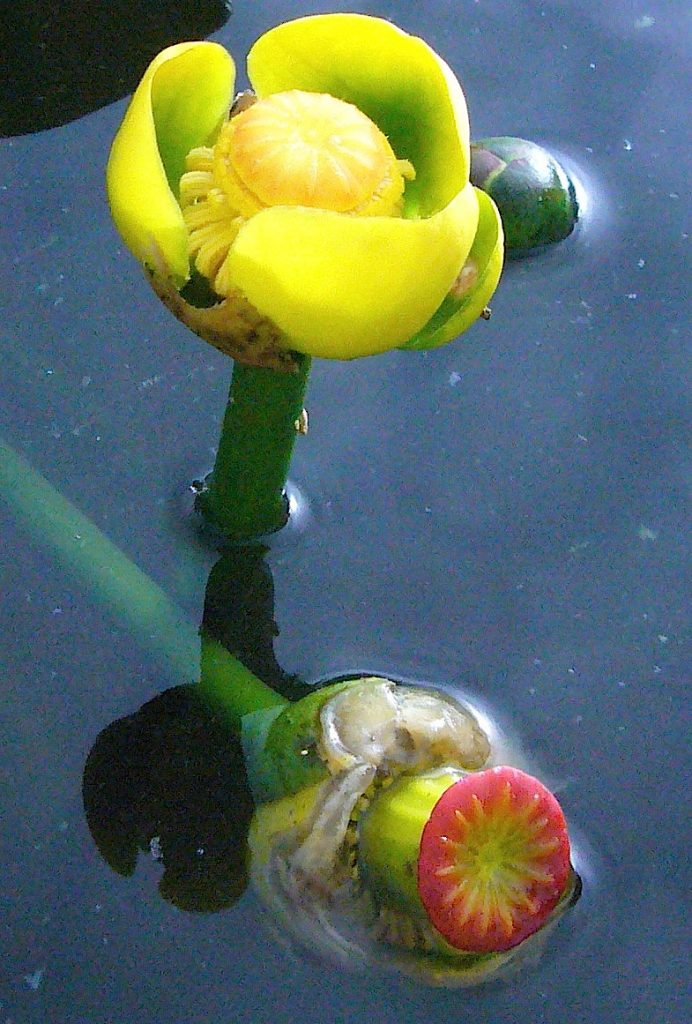
Yellow Pond Lilly putting on a seed pod. Photo by Green Deane
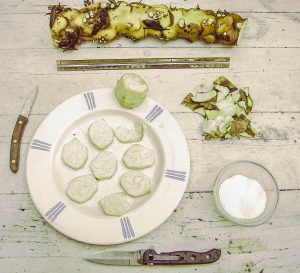
Why don’t you see more Yellow Pond Lilly roots on a plate? Because they are not edible. Photo by Green Deane
Fall is a good time to look for Yellow Pond Lilys. While they fruit rather continuously these pond residents are putting forth a crop now. Plants may not have a brain they can have a strategy, or at least so it seems. Many of them protect their seeds in various ways until they are ready to germinate. The Persimmon Tree comes to mind. The fruit is astringent until the seeds are mature enough to germinate. Then the fruit turns sweet attracting various animals to eat it — those that can taste sweet — and spread the seeds around. The Monstera deliciosa has the same saccharin strategy. The seeds are acrid until ready to germinate then they turn sweet. They have a flavor reminiscent of pineapple and/or wild chamomile. The Yellow Pond Lily works in a similar fashion, almost. It does not turn sweet but the bitterness goes away. Seeds that are not ready to germinate are bitter. As the plant dies the floating seed pod rots over a three-week period. When the seeds are ready to germinate the protective bitterness is removed by enzymatic action. This also makes the seeds edible. Of course we humans can take advantage of the system by collecting the seed pods ourselves and controlling the rotting process. Then we get the seeds and dry them for use in various ways. You can read more about the Yellow Pond Lily here.
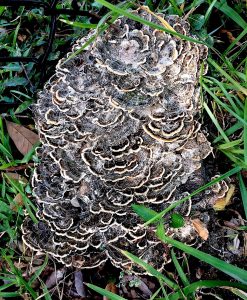
True Turkey Tails. Photo by Green Deane
Turkey Tails are fairly easy to identify medicinal mushroom. For a common type of mushroom I don’t see them that often… two or three times a year. I see False Turkey Tails far more often. More on that later. A seven-year study funded by the National Institutes of Health found Turkey Tail (Trametes versicolor) boosted the immunity in women who had been treated for breast cancer. Researchers at the University of Minnesota and Bastyr University conducted the study in women with stages I-III breast cancer who had completed radiation therapy or chemotherapy. Results showed that immune function was enhanced in the women who took daily doses of Turkey Tail in pill form. They reported that the improved immune response was dose dependent and that none of the subjects suffered any adverse effects. Trametes versicolor can be chewed whole, eaten ground, or made into a tea, or a tincture. The question that always follows such comments is are False Turkey Tails, Stereum ostrea, medicinal? Informally one hears herbalists saying False Turkey Tails can be used but there are few specifics though it has a long herbalism history. A study in 2007 found that water extracts of Stereum ostrea were antibacterial and antifungal. That’s not cancer fighting or immune system stimulating but useful nonetheless. You can read that article here.
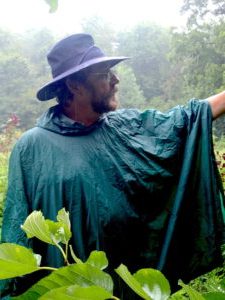
Classes are held rain or shine.
Hopefully Hurricane Delta will stay west enough this week to bring tolerable rain here. Saturday I have a class in Largo at Eagle Lake Park. Always an interesting area to visit. Sunday we are having our second Orlando Mushroom Group (OMG) outing. This is a mushroom hunt in Lake Mary. The two big if’s are whether the weather will cooperated and what will be up for mushrooms. The season for terrestrial mushrooms is not over but this month they do diminish.
Saturday, October 10th, Eagle Park Lake, 1800 Keene Road, Largo, FL 33771. Meet at the pavilion near the dog park. 9 a.m. to noon. This is presuming the weather will cooperate. We might be ducking Gulf-of-Mexico storms that weekend.
Sunday, October 11th. Shall we try an end-of-the-season mushroom class? Mushrooms are as fickle as the weather so whether we will find any is luck of the draw. Long-range weather forecasts say will could have a lot of rain between now and then so who knows. Maybe there will be a late-season flush. We should at least find some to study. This class is taught with Joshua Buchanan and the fee for this particular class is $10 per adult. Time 9 a.m. to noon. Location: 8515 Markham Road, Lake Mary Fl. 32746. There’s ample parking, drinking water, and rest rooms. Do not bring mushroom baskets. If you are going to collect (for study of course) put them in a back pack or bag or the like. If you have any questions email me: GreenDeane@gmail.com.
Saturday, October 17th, Bayshore Live Oak Park, Bayshore Drive. Port Charlotte. 9 a.m. to noon. Meet at the parking lot of Bayshore and Ganyard Street. We walk beside the Peace River and do a neighborhood wander.
Saturday, October 18th, Seminole Wekiva Trail, Sanlando Park, 401 West Highland St. Altamonte Springs, Florida 32714 (at the intersection with Laura Avenue.) We meet in the first parking lot on your right immediately after the entrance. 9 a.m. to noon. This compact tour I do once or twice a year includes unmanaged woods, a park, baseball fields, and a visit to the Little Wekiva River. 9 a.m. to noon.
Saturday, October 24th, Blanchard Park, 10501 Jay Blanchard Trail, Orlando, FL 32817. 9 a.m to noon. Meet at the pavilion by the tennis courts by the YMCA building.
Sunday, November 1st, Dreher Park, 1200 Southern Blvd., West Palm Beach, 33405. Take exit 68 (Southern Boulevard) off Interstate 95 and go east. Entrance to the park is an immediate right at the bottom of the interstate bridge. Follow the convoluted signs to the science center (which is not where the GPS puts you.) Park anywhere. We meet 300 feet north of the science museum near the banyan tees. 9 a.m. to noon.
For more information about the classes, to pre-pay, or to sign up go here.
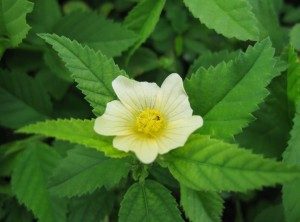
Sida leaves and roots has ephedrine.
Is it Sida (SEE-dah) or is it Sida (SIGH-dah)? Either either it would seem… There are several members of the Sida genus locally and they blossom nearly all year. This weekend, however, Sida cordifolia was particularly happy. Taller and softer than some of the other genusmates, it’s a plant with a little bit of legal history. Plants in the genus tend to have ephedrine in them to varying amounts. Sida cordifolia, however, is the only Sida species mentioned in the Florida Statutes. If you make a pill using the plant it cannot be given to anyone under the age of 18. I doubt the problem is bootleg diet pills but rather youthful experimenting with ephedrine. Adults can apparently do what they want with the plant. S. cordifolia is not native. The species I see the most often is S. rhombifolia, which means diamond shape. The lower part of the leaves of that species do not have teeth on them. We also saw one during our class in Jacksonville Sunday. That might have been Sida acuta. You can read more about Sida here.
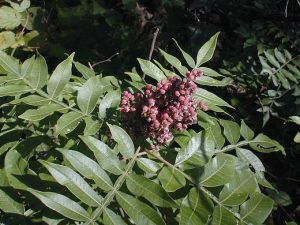
Winged Sumac. Photo by Green Deane
Our Sumacs are happy. Everywhere you go now they are sporting terminal clusters of garnet-colored berries. It is time to harvest Sumacs for use today or later. There’s a wide variety of Sumacs. Perhas 325 in the genus. Locally it’s the “Wing Sumac.” In other areas of the country it can be the Staghorn Sumac which I grew up nibbling in Maine. Shapes and quality vary but they always have terminal clusters of garnet-colored berries, give or take a hue. The berries have hair on them. And on the hair is malic acid, the acid that makes apples tart. You can rinse the acid off the acid and make a lemonade-like drink. The berries can be dried, their coating knocked off then ground and used as a spice. Surprisingly Sumacs are high in the B vitamins but rather low in ascorbic acid which is nature’s form of vitamin C. I currently have three gallons of Sumac wine working. I hope to bring some to classes next fall. In the springtime the shoots can be peeled and eaten raw or cooked. If you are worried about Poison Sumac it grows only in wet spots, has a much different leaf, and when in fruit has white berries positioned farther down the stem, not terminal clusters. Also Poison Sumac leaves have bright red stems.
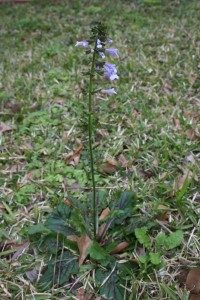
Lyre-Leaf Sage. Photo by Green Deane
In his book Edible Plants of North America, Francois Couplan writes on page 384: “the leaves of the S. lyrata, Eastern North America, contain an acrid principle and should not be ingested. They have been used to remove warts.” That said I know an herbalist who makes a tea from the leaves and a foraging instructor who cooks the young leaves and eats them. I’ve heard other reports of them being eaten. That can leave a person in a tough spot as to what to do with the plant. To eat or not to eat, that is the question.
Another example is also a sage, Salvia coccinea, also known as Tropical Sage. A small piece of the blossom of this species — a very tiny piece, 1/8 inch square — made me horribly sick for several weeks. It attacked my stomach with viciousness and I was go-to-the-emergency room miserable. Coca-cola syrup and Pepto-Bismol combined were my salvation from doubled-over pain. I was actually “field testing” this plant for edibility at the time, one reason why I am very opposed to field testing. Yet, I know of two people who have eaten the young leaves with no problem. Perhaps it was a personal allergy on my part. I don’t know. But I do know I will never eat any part of that plant again. Ever. Lesson painfully learned. Yet it might be edible, or maybe some folks really do have cast iron stomachs. I know I don’t. Eating this Sage is one of those “you’re on your own” kind of things.
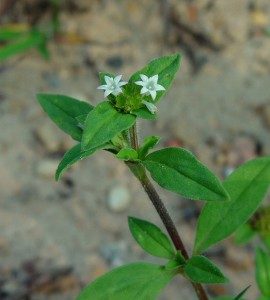
Richardia is generally not edible.
A third plant that falls into the crack between edible and not edible is Richardia scabra, aka Florida Pusley. It is in a genus that has species used to make you throw up. In fact one is called Richardia emetica. That is not encouraging. Some people mistake R. scabra for chickweed, which is a Stellaria, a totally different genus. The plants vaguely resemble each other if one ignores several details and that fact that real chickweed only grows here in the winter time. R. scabra is a species for which I have never found any ethnobotanical references to regarding edibility. In fact it is one of three common plants that seems to have either not been used by the natives or somehow were not reported. The other two are Amaranthus australis and Hibiscus moscheutos. I know from modern reports that A. australis is edible but as for the H. moscheutos I have no idea though it comes from a very edible genus. Thus R. scabra is not on my site as an edible because I can’t find any historical reference to its use. Curiously the internet now calls it “edible.” I do know two people who mistook it for chickweed and ate it for quite a while. And I know two people who did not mistake it; they know it is a Richardia and they eat it from time to time. That might be a key element. Without any ethnobotanical reference perhaps a little now and then is okay but a steady diet of it is not. It is one of those unknown things. Sometimes eating little bits of this or that do not rise to the level of making you ill. I know a person who mistook Oak Leaf Fleabane (Erigeron quercifolius) for for Plantago major and ate some for quite a while without an apparent problem. And I have personally seen someone eat a leaf of Oak Leaf Fleabane against my advice. She was still standing at the end of class. So there are definitely edible plants, and there are definitely non-edible plants. But there can be some fog in between.

Green Deane videos are now available on a USB.
Changing foraging videos: My nine-DVD set of 135 videos has been selling for seven years and are still available. They are the same videos I have on You Tube. Some people like to have a separate copy. A second option is a16-gig USB that has those 135 videos plus 15 more. While the videos can be run from the DVDs the videos on the USB have to be copied to your computer to play. They are MP4 files. The150-video USB is $99 and the 135-video DVD set is now $99. The DVDs will be sold until they run out then will be exclusively replaced by the USB. This is a change I’ve been trying to make for several years. So if you have been wanting the 135-video DVD set order it now as the price is reduced and the supply limited. Or you can order the USB. My headache is getting my WordPress Order page changed to reflect these changes. We’ve been working on it for several weeks. However, if you want to order now either the USB or the DVD set make a $99 “donation” using the link at the bottom of this page or here. That order form provides me with your address, the amount — $99 — tells me it is not a donation and in the note say if you want the DVD set or the USB.

Green Deane Forum
Want to identify a plant? Perhaps you’re looking for a foraging reference? You might have a UFO, an Unidentified Flowering Object, you want identified. On the Green Deane Forum we — including Green Deane and others from around the world — chat about foraging all year. And it’s not just about warm-weather plants or just North American flora. Many nations share common weeds so there’s a lot to talk. There’s also more than weeds. The reference section has information for foraging around the world. There are also articles on food preservation, and forgotten skills from making bows to fermenting food.
This is weekly newsletter #426, If you want to subscribe to this free newsletter you can find the sign-up form in the menu at the top of the page.
To donate to the Green Deane Newsletter click here.

